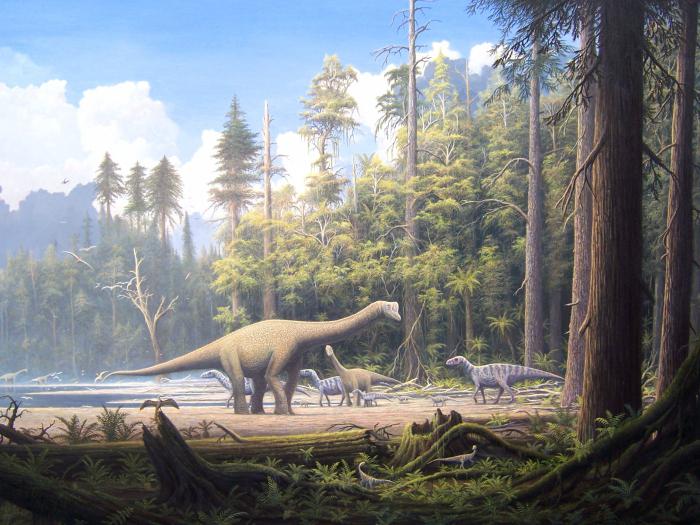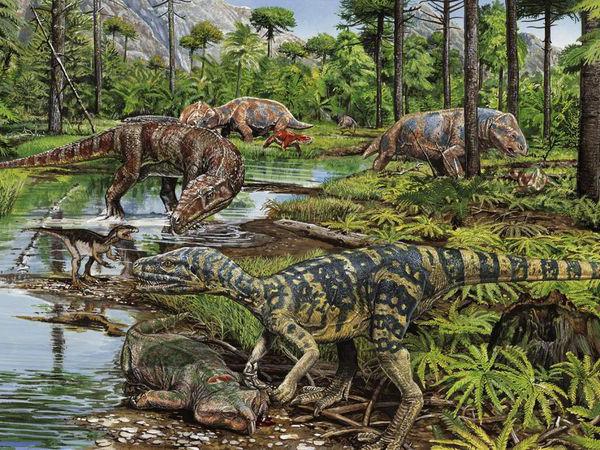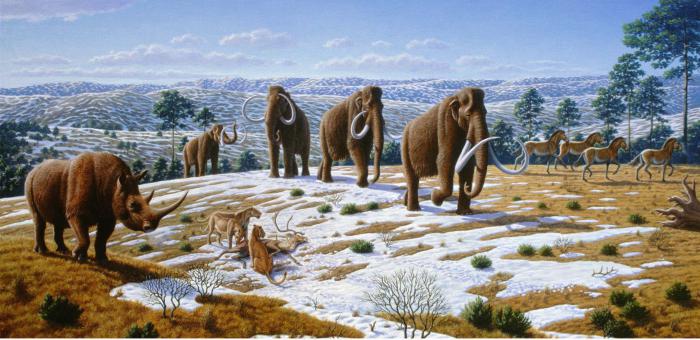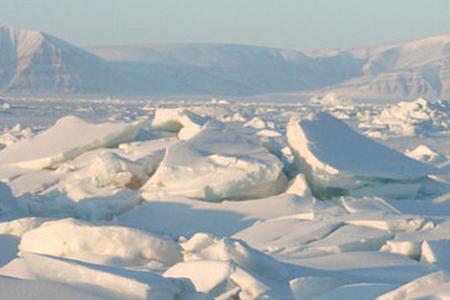According to modern ideas of scientists, the geological history of our planet is 4.5-5 billion years. In the process of its development, it is customary to distinguish the geological periods of the Earth.
general information
The geological periods of the Earth (the table below) are a sequence of events that have occurred during the development of the planet since the formation of the earth's crust on it. Over time, various processes take place on the surface, such as the emergence and destruction of landforms, submergence of land under water and their raising, glaciation, as well as the appearance and disappearance of various species of plants and animals, etc. Our planet bears obvious traces his education. Scientists claim that they are able to fix them with mathematical accuracy in different layers of rocks.
Major sediment groups
Geologists, trying to restore the history of the planet, are studying rock strata. Accepted sediment data are divided into five main groups, highlighting the following geological eras of the Earth: the oldest (Archean), early (Proterozoic), ancient (Paleozoic), middle (Mesozoic) and new (Cenozoic). It is believed that the border between them runs along the largest evolutionary events that have occurred on our planet. The last three eras, in turn, are divided into periods, since the remains of plants and animals are most clearly preserved in these deposits. Each stage is characterized by events that have had a decisive influence on today's terrain.
Oldest stage
The Archean era of the Earth was characterized by rather violent volcanic processes, as a result of which magmatic granite rocks appeared on the planet's surface - the basis for the formation of continental plates. At that time, there were only microorganisms that could do without oxygen. It is assumed that deposits of the Archean era cover almost the entire area of the continents with an almost complete shield, they contain a lot of iron, silver, platinum, gold and ores of other metals.
Early stage
The Proterozoic era is also characterized by high volcanic activity. During this period, mountain ranges of the so-called Baikal folding were formed. They have not survived to the present day, today they are just a few insignificant uplifts on the plains. During this period, the Earth was inhabited by the simplest microorganisms and blue-green algae, the first multicellular ones appeared. The Proterozoic rock stratum is rich in minerals: mica, non-ferrous metal ores and iron ores.
Ancient stage
The first period of the Paleozoic era was marked by the formation of mountain ranges of the Caledonian folding. This has led to a significant reduction in marine basins, as well as the emergence of vast land areas. Separate ridges of that period have survived to our days: in the Urals, in Arabia, Southeast China and Central Europe. All these mountains are "worn out" and low. The second half of the Paleozoic is also characterized by mountain building processes. Ranges of Hercynian folding formed here. This era was more powerful, vast mountain ranges arose in the Urals and Western Siberia, Manchuria and Mongolia, Central Europe, as well as Australia and North America. Today they are represented by very low block massifs. Animals of the Paleozoic era are reptiles and amphibians, seas and oceans are inhabited by fish. Among the plant world, algae prevailed. The Paleozoic era (Carboniferous) is characterized by large deposits of coal and oil, which arose precisely in this era.
Mid stage
The beginning of the Mesozoic era is characterized by a period of relative calm and gradual destruction of the mountain systems created earlier, plunging of the flat territories (part of Western Siberia) under water. The second half of this period was marked by the formation of ridges of the Mesozoic folding. Very vast mountainous countries have appeared, which today have the same appearance. As an example, one can cite the mountains of Eastern Siberia, the Cordillera, and separate sections of Indochina and Tibet. The land was densely covered with lush vegetation, which gradually died off and rotted. Due to the hot and humid climate, active formation of peat bogs and swamps took place. It was an era of giant dinosaurs - dinosaurs. Inhabitants of the Mesozoic era (herbivores and carnivores) spread throughout the entire planet. At the same time, the first mammals appeared.
New stage
The Cenozoic era, which replaced the middle stage, continues to this day. The beginning of this period was marked by an increase in the activity of the internal forces of the planet, which led to the general uplift of vast tracts of land. This era is characterized by the emergence of mountain ranges of alpine folding within the Alpine-Himalayan belt. During this period, the Eurasian continent acquired modern outlines. In addition, there was a significant rejuvenation of the ancient massifs of the Urals, Tien Shan, Appalachians and Altai. The climate on Earth dramatically changed, periods of powerful cover glaciations began. The movements of glacial masses altered the relief of the continents of the Northern Hemisphere. As a result, hilly plains formed with a huge number of lakes. Animals of the Cenozoic era are mammals, reptiles and amphibians, many representatives of the initial periods have survived to this day, others have died out (mammoths, woolly rhinos, saber-toothed tigers, cave bears and others) for one reason or another.

What is a geological period?
The geological stage as a unit of the geochronological scale of our planet is usually divided into periods. Let's see what the term says in the encyclopedia. The period (geological) is a large interval of geological time during which rocks were formed. In turn, it is divided into smaller units, which are commonly called eras.
The first stages (Archean and Proterozoic) due to the complete absence or insignificant amount of deposits of animal and plant nature in them are not accepted to be divided into additional areas. The Paleozoic era includes the Cambrian, Ordovician, Silurian, Devonian, Carboniferous and Permian periods. This stage is characterized by the largest number of sub-intervals, the rest are limited to only three. The Mesozoic era includes the Triassic, Jurassic and Cretaceous stages. The Cenozoic era, the periods of which are the most studied, is represented by the Paleogene, Neogene, and Quaternary sub-interval. Let us consider in more detail some of them.
Triassic
The Triassic period is the first sub-interval of the Mesozoic era. Its duration was about 50 million years (the beginning - 251-199 million years ago). It is characterized by the renewal of marine and terrestrial fauna. At the same time, a few representatives of the Paleozoic continue to exist, such as spiriferide, tabulate, some lamellar-gill, and others. Among invertebrates, ammonites are very numerous, giving rise to many new forms important for stratigraphy. Six-beam forms predominate among corals, of brachiopods - terebratulides and rhinchonelids, and in the group of echinoderms - sea urchins. Vertebrate animals are mainly represented by reptiles - large dinosaur dinosaurs. Widespread tecodonts - land fast-moving reptiles. In addition, in the Triassic period, the first large inhabitants of the aquatic environment appear - ichthyosaurs and plesiosaurs, but they reach their heyday only in the Jurassic period. Also at this time the first mammals appeared, which were represented by small forms.

Flora in the Triassic (geological) period loses the elements of the Paleozoic and acquires exclusively Mesozoic composition. Fern species of plants, sago-shaped, coniferous and ginkgoids prevail here. Climatic conditions are characterized by significant warming. This leads to the drying out of many inland seas, and in the remaining, the level of salinity increases significantly. In addition, the area of inland water bodies is very reduced, resulting in the development of desert landscapes. For example, the Taurida Formation of the Crimean Peninsula belongs to this period.
Yura
The Jurassic period got its name thanks to the Jurassic Mountains in Western Europe. It forms the middle part of the Mesozoic and most closely reflects the main features of the development of organics of this era. In turn, it is customary to divide it into three departments: lower, middle and upper.
The fauna of this period is represented by widespread invertebrates - cephalopods (ammonites, represented by numerous species and genera). According to the sculpture and the nature of the shells, they differ sharply from the representatives of the Triassic. In addition, in the Jurassic period, another group of mollusks, belemnites, flourished. At this time, six-rayed reef-forming corals, sea sponges, lilies and hedgehogs, as well as numerous lamellar-gill, reach significant development. But the species of the Paleozoic brachiopod completely disappears. The marine fauna of vertebrate species is significantly different from the Triassic, it reaches a huge variety. In the Jurassic period, fish are widely developed, as well as aquatic reptiles - ichthyosaurs and plesiosaurs. At this time, there is a transition from land and adaptation to the marine environment of crocodiles and turtles. Huge diversity is reached by various types of terrestrial vertebrates - reptiles. Among them, dinosaurs come to their heyday, which are represented by herbivores, predators and other forms. Most of them reach 23 meters in length, for example, diplodocus. In the sediments of this period, a new type of reptile is found - flying lizards, which are called "pterodactyls." At the same time, the first birds appeared. The flora of the Jurassic reaches a lush flowering: gymnosperms, ginkgoids, cicadas, conifers (araucaria), bennettites, cypresses, and, of course, ferns, horsetails and crowns.

Neogene
The Neogene period is the second period of the Cenozoic era. It began 25 million years ago and ended 1.8 million years ago. At this time, significant changes in the composition of the fauna took place. There is a wide variety of gastropods and bivalves, corals, foraminifers and coccolithophores. Amphibians, sea turtles and bony fishes are widely developed. In the Neogene period, terrestrial vertebral forms reach a great diversity. For example, fast-progressing hipparion species appeared: hipparions, horses, rhinos, antelopes, camels, proboscis, deer, hippos, giraffes, rodents, saber-toothed tigers, hyenas, anthropoids and others.
Under the influence of various factors, the organic world is rapidly evolving at this time: forest-steppes, taiga, mountain and plain steppes arise. In tropical areas - savannas and moist forests. Climatic conditions are approaching modern.
Geology as a science
The geological periods of the Earth are studied by science - geology. It appeared relatively recently - at the beginning of the 20th century. However, despite its youth, it is a resin to shed light on many controversial issues about the formation of our planet, as well as the origin of its creatures. There are few hypotheses in this science, mainly only the results of observations and facts are used. No doubt, traces of the planet’s development stored in the earth’s layers will in any case give a more accurate picture of the past than any written book. However, not everyone is able to read these facts and understand them correctly, therefore, even in this exact science, erroneous interpretations of certain events may arise from time to time. Where there are traces of fire, it is safe to say that there was fire; and where there are traces of water, with the same confidence it can be argued that there was water and so on. Nevertheless, mistakes also happen. In order not to be unfounded, consider one such example.

“Frosty patterns on glasses”
In 1973, the magazine “Knowledge is Power” published an article by the famous biologist A. A. Lyubimtsev “Frosty patterns on glasses”. In it, the author draws the attention of readers to the striking similarity of ice patterns with plant structures. As an experiment, he photographed a pattern on glass and showed the photograph to a familiar nerd. And without slowing down, he recognized a fossilized thistle trace in the picture. From the standpoint of chemistry, these patterns arise due to gas-phase crystallization of water vapor. However, something similar happens when pyrolytic graphite is produced by pyrolysis of methane diluted with hydrogen. So, it was found that aside from this flow, dendritic forms are formed that are very similar to plant debris. This is explained by the fact that there are general laws that govern the formation of forms in inorganic matter and living nature.
For a long time, geologists dated each geological period, relying on traces of plant and animal forms found in coal deposits. And only a few years ago there were statements by some scientists that such a method is incorrect and that all the fossils found are nothing more than a by-product of the formation of the earth's layers. No doubt, you can’t measure everything the same way, but you need to more carefully approach dating issues.
Was there a worldwide glaciation?
Let's consider one more categorical statement of scientists, and not only geologists. Starting from school, we were all told about the global glaciation that has covered our planet, as a result of which many species of animals have died out: mammoths, woolly rhinos, and many others. And the modern younger generation is brought up on the quadrology “Ice Age”. Scientists unanimously argue that geology is an exact science that does not admit theories, but uses only verified facts. However, this is not the case. Here, as in many fields of science (history, archeology and others), one can observe the ossification of theories and the steadfastness of authorities. For example, since the end of the nineteenth century, there has been heated debate on the sidelines of science about whether glaciation or not. In the mid-twentieth century, the famous geologist I. G. Pidoplichko published a four-volume work “On the Ice Age”. In this work, the author gradually proves the insolvency of the version of global glaciation. He does not rely on the works of other scientists, but on the geological excavations he personally carried out (moreover, he spent part of them as a fighter of the Red Army, participating in battles against the German invaders) throughout the territory of the Soviet Union and Western Europe. He argues that the glacier could not cover the entire continent, but was only local in nature, and that it did not cause the extinction of many species of animals, but completely different factors - these are catastrophic events that led to a pole shift (Sensational History of the Earth, A . Sklyarov); and the economic activities of man himself.

Mystery, or why scientists do not notice the obvious
Despite the irrefutable evidence provided by Pidoplichko, scientists are in no hurry to abandon the accepted version of glaciation. And then even more interesting. The author’s works were published in the early 50s, but with the death of Stalin all copies of the four-volume were removed from the libraries and universities of the country, preserved only in the library’s reserves, and getting them from there is not easy. In Soviet times, everyone who wanted to take this book in the library was registered with the special services. And even today, there are certain problems in getting this print edition. However, thanks to the Internet, everyone can get acquainted with the works of the author, who in detail analyzes the periods of the geological history of the planet, explains the origin of certain traces.
Is geology an exact science?
It is believed that geology is an exclusively experimental science that draws conclusions only from what it sees. If the case is doubtful, she does not approve anything, expresses an opinion that can be discussed, and puts off the final decision until unambiguous observations are obtained. However, as practice shows, the exact sciences are also mistaken (for example, physics or mathematics). Nevertheless, mistakes are not a disaster if they are accepted and corrected on time. Often they are not global in nature, but are of local importance, you only need to have the courage to accept the obvious, draw the right conclusions and move on to meet new discoveries. But modern scientists show radically opposite behavior, because most of the luminaries of science at one time received titles, awards and recognition for their activities, and today they do not want to part with them at all. And such behavior is seen not only in geology, but also in other areas of activity. Only strong people are not afraid to admit their mistakes, they rejoice at the opportunity to develop further, because detecting an error is not a catastrophe, but rather a new opportunity.